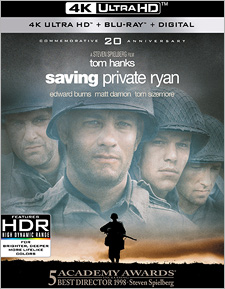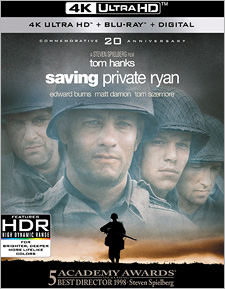Saving Private Ryan: 20th Anniversary Edition (4K UHD Review)

Director
Steven SpielbergRelease Date(s)
1998 (May 8, 2018)Studio(s)
Amblin/Mutual Film/DreamWorks (Paramount Pictures)- Film/Program Grade: A+
- Video Grade: A+
- Audio Grade: A+
- Extras Grade: B+
Review
It’s hard to comprehend, as we live out our daily lives in today’s modern world of convenience, the kind of sacrifice that was asked of an entire generation of Americans not so very long ago. Seventy-four years seems like forever, but almost all of us have family stories of World War II, stories of the ways in which it impacted our grandparents and eldest relatives. We’ve had plenty of conflict in our day, to be sure, but no World Wars, no drafts. How would we respond to such events? How many of us today would be willing to make the ultimate sacrifice to preserve our freedom? That’s the real genius of Steven Spielberg’s Saving Private Ryan. It would be difficult to sit through this film and not ask yourself, “What would I do, faced with that situation?”
The film starts on perhaps the most important day of the war – the D-Day invasion of Europe on June 6th, 1944. We watch as thousands of Average Joes storm the beach at Normandy, only to be cut to pieces in a hail of machine-gun bullets and mortar fire. In the ensuing chaos, small groups of men manage to make their way up the beach. And faced with the choice of fighting for a chance at survival by breaking through the German lines of defense, or simply dying on the beach, slowly the American and Allied soldiers claw their way to victory.
One such group of men is led by Captain John Miller (Tom Hanks). After scaling the cliffs and overcoming the odds in the first wave of the invasion, Miller and his men are given a seemingly ridiculous mission. It seems that, somewhere in midst of the vast war, a private named Ryan has lost three of his brothers in action. The Army has decided to spare his mother the agony of losing all her sons, so Miller and his men are ordered to go deep behind enemy lines in France, to find Ryan and bring him home. Along the way, they’ll risk their own lives in what seems a hopeless task, all the while thinking that no one soldier could possibly be worth the sacrifice.
Director Steven Spielberg has, with this film, created perhaps the single greatest testament to that generation, and that specific day, yet captured on film. Certainly, (for better or worse) Saving Private Ryan will be remembered by more people than any other record of those dark days. But it’s also arguably the most accurate, visceral account of the events of D-Day. Spielberg wisely chose to eschew a traditional Hollywood filmmaking style for this project, opting instead for a gritty, combat camera feel to the picture. The result, particularly in its first thirty minutes (which recreates the invasion at Normandy itself), is one of the most effective pieces of war filmmaking you will ever see. Spielberg places you right in the midst of the action with Miller and his men, with gunfire whizzing all around. You experience your own small form of shell shock, as you watch wave after wave of young men being shot down and blown to bits.
Once the invasion ends, and the story expands to the actual search for Ryan, the characters become all too human. Hanks, Tom Sizemore, Edward Burns, Matt Damon and the rest all fit together perfectly. We come to understand each of these characters, their backgrounds, their fears, and the unspoken bond they slowly develop with one another. These are ordinary people in extraordinary circumstances, fighting because they must – fighting because freedom doesn’t come free, and the price of freedom must too often paid in blood.
Saving Private Ryan was shot on 35 mm film (using a variety of camera platforms) with spherical lenses. Its iconic invasion sequence and other battle footage was filmed handheld by cinematographer Janusz Kaminski using reduced shutter speeds to recreate the “chattering” visual blur effect often seen in real combat footage. The original film master was scanned in native 4K for this release and given color grades in both HDR10 and Dolby Vision. The result is presented here on Ultra HD Blu-ray at the original 1.85:1 theatrical aspect ratio. The first word that comes to mind is “WOW.” There is a dramatic increase in both fine detail and the precision of the texturing in this image. It’s quite striking. You see it in many things, including facial details, skin, worn canvas fabrics, sand, grit, and most especially in the rubble of buildings, in piles of shattered brick, stone, and wood. Photochemical grain is present at all times in moderate amounts. It’s always been a little noisy – perhaps gritty would be the better choice of word – and that’s by design, though it’s organic and never seems unnatural to this particular film.
As good as the detail is in this 4K image, however, it’s the High Dynamic Range grading that really delivers the knock-out punch. Contrasts are extraordinarily deep, while the sky has an oppressively gloomy-bright quality that casts dark shadows over faces beneath helmets. And the color is just jaw-dropping, all the more striking for the fact that much of the film has a muted quality, so when the color does pops it really explodes off the screen, as when the blood-filled waves wash over the dead soldiers on the beach, or when the orange blast of a flamethrower explodes from the slits of a German pillbox. There’s a shot of Captain Miller, as he’s waiting to report to a superior officer (right after the open battle finishes), where you see a remarkable range of coloring in his face, not just the normal tones you’d see but his skin has clearly been blasted by wind, waves, and combat, and there’s dirt and grime visible, all of which expresses itself in an amazing variety of subtle colors and shadings. This is a beautiful 4K presentation, a truly cinematic image, and I never want to see the film in any other way.
Audio on the 4K disc is presented in a new object-based English Dolby Atmos mix. Now... to be fair, the audio experience of this film on regular Blu-ray has always been spectacular, given the previous DTS-HD Master Audio lossless track. It was hard to imagine that an object-based mix could improve upon this, but it does, though it’s not as much of an improvement as the visual presentation. Clarity is superb, with tremendous dynamics, rock-solid base, and a medium-wide soundstage. Surround panning and atmospherics are aggressive and smooth, as always, though the Atmos mix lends them a greater degree of precision than before. The height channels enclose the sound environment overhead but are also quite active and really kick in often during the opening D-Day invasion sequence, throughout all the various combat scenes, and also at the end of the film, when the P-51 Mustangs roar in from above. Dialogue is clean and John Williams’ score has never sounded better. Once again, this is a reference quality experience. Additional audio options include the original English 5.1 Dolby Digital mix, English Descriptive Audio, and 5.1 Dolby Digital in German, Spanish, Latin Spanish, French, Italian, Japanese, and Portuguese, with optional subtitles available in English, English for the Hearing Impaired, Danish, German, Spanish, Latin Spanish, French, Italian, Japanese, Dutch, Norwegian, Brazilian Portuguese, Finnish, and Swedish.
Paramount’s 4K Ultra HD package is a 3-disc set that includes the movie-only UHD disc, along with previous 2-disc Blu-ray special edition. The first Blu-ray is movie-only as well (note that it does not appear to be mastered from the new 4K scan), while the second Blu-ray is a special features disc that includes the following content (most of it in SD and full frame, as it was produced for the original 1999 DVD release):
- An Introduction (2:35)
- Looking into the Past (4:40)
- Miller and His Platoon (8:23)
- Boot Camp (7:37)
- Making Saving Private Ryan (22:05)
- Re-creating Omaha Beach (17:58)
- Music and Sound (15:59)
- Parting Thoughts (3:43)
- Into the Breach: Saving Private Ryan (25:01)
- Theatrical Trailer (HD – 2:16)
- Re-release Trailer (HD – 2:05)
- Shooting War (88:05)
The only thing missing from the original DVD release is the Message from Steven Spielberg (replaced here by An Introduction), and the Price for Peace: From Pearl Harbor to Nagasaki documentary bonus DVD from the 2004 Saving Private Ryan: World War II Collection box set (the documentary is available seperately on DVD if you wish to track it down). Of course, you also get a Digital Copy code on a paper insert.
Saving Private Ryan is one of Spielberg’s finest films, a vivid, emotion-wrenching, and cinematic crucible that everyone should see at least once. As good as the film experience has been previously in theaters and on disc, there can be no better way to view it now than Paramount’s new 4K Ultra HD release. It offers a reference-grade A/V presentation, with genuine improvements in both picture and sound quality. It’s not just highly recommended, but a must-have title on this format.
- Bill Hunt
(You can follow Bill on social media at these links: Twitter and Facebook)

